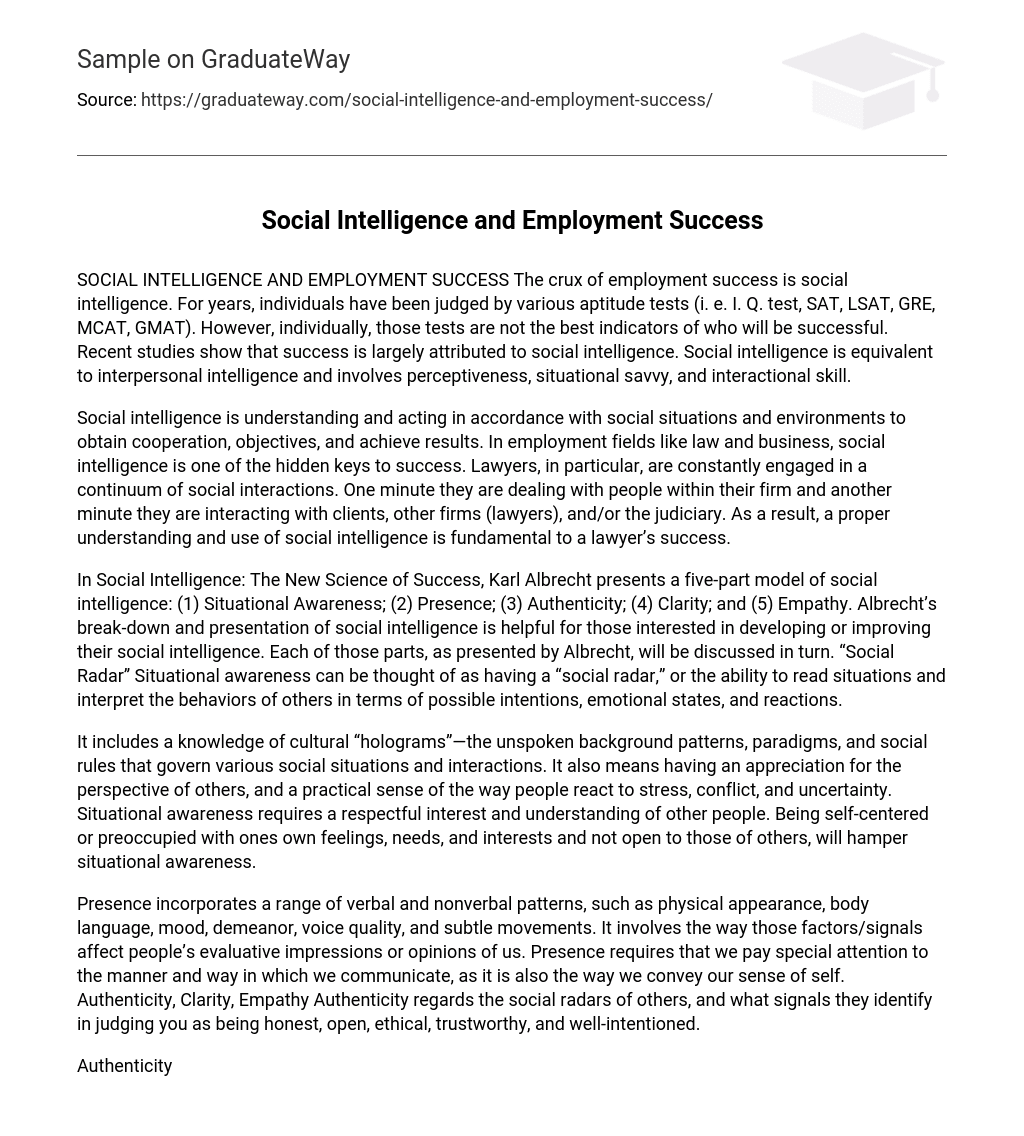SOCIAL INTELLIGENCE AND EMPLOYMENT SUCCESS The crux of employment success is social intelligence. For years, individuals have been judged by various aptitude tests (i. e. I. Q. test, SAT, LSAT, GRE, MCAT, GMAT). However, individually, those tests are not the best indicators of who will be successful. Recent studies show that success is largely attributed to social intelligence. Social intelligence is equivalent to interpersonal intelligence and involves perceptiveness, situational savvy, and interactional skill.
Social intelligence is understanding and acting in accordance with social situations and environments to obtain cooperation, objectives, and achieve results. In employment fields like law and business, social intelligence is one of the hidden keys to success. Lawyers, in particular, are constantly engaged in a continuum of social interactions. One minute they are dealing with people within their firm and another minute they are interacting with clients, other firms (lawyers), and/or the judiciary. As a result, a proper understanding and use of social intelligence is fundamental to a lawyer’s success.
In Social Intelligence: The New Science of Success, Karl Albrecht presents a five-part model of social intelligence: (1) Situational Awareness; (2) Presence; (3) Authenticity; (4) Clarity; and (5) Empathy. Albrecht’s break-down and presentation of social intelligence is helpful for those interested in developing or improving their social intelligence. Each of those parts, as presented by Albrecht, will be discussed in turn. “Social Radar” Situational awareness can be thought of as having a “social radar,” or the ability to read situations and interpret the behaviors of others in terms of possible intentions, emotional states, and reactions.
It includes a knowledge of cultural “holograms”—the unspoken background patterns, paradigms, and social rules that govern various social situations and interactions. It also means having an appreciation for the perspective of others, and a practical sense of the way people react to stress, conflict, and uncertainty. Situational awareness requires a respectful interest and understanding of other people. Being self-centered or preoccupied with ones own feelings, needs, and interests and not open to those of others, will hamper situational awareness.
Presence incorporates a range of verbal and nonverbal patterns, such as physical appearance, body language, mood, demeanor, voice quality, and subtle movements. It involves the way those factors/signals affect people’s evaluative impressions or opinions of us. Presence requires that we pay special attention to the manner and way in which we communicate, as it is also the way we convey our sense of self. Authenticity, Clarity, Empathy Authenticity regards the social radars of others, and what signals they identify in judging you as being honest, open, ethical, trustworthy, and well-intentioned.
Authenticity is fundamental to developing rapport and people’s perspective of you. It requires that you constantly assess your actions, and whether people will interpret you as being “authentic. ” Clarity is the ability to explain oneself, illuminate ideas, articulate views, proposed courses of action, and pass data clearly and accurately. Clarity is fundamental to effective communication and cooperation. It requires being an active and attentive listener so one can adequately and effectively respond to an individual or group.
Empathy, in the context of social intelligence, goes beyond its plain definition. It entails having the ability to sympathize with another but includes having a shared feeling between two people. It is a state of connectedness with another person, which creates the basis for positive interaction. That interconnectedness inspires people to cooperate. It is a condition of rapport. To achieve empathy with another person means getting that person to have a shared feeling of connectedness with you, which leads them to move with and toward you rather than against you.
Accordingly, empathy requires avoiding or abandoning toxic behaviors, and adopting or increasing nourishing behaviors toward other people. When taken together, understood, and employed, these five-parts of social intelligence can foster effective client counseling and client-attorney interaction in addition to intra and inter-firm (attorney) interactions—whether or not they are in court, during negotiations, or involve general interactions. Importantly, social intelligence can help maintain and develop working relationships with judicial figures.





